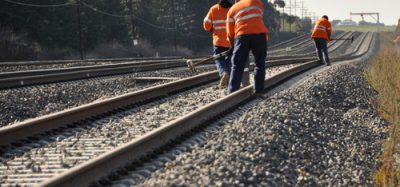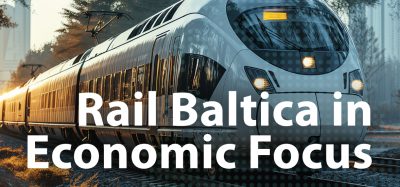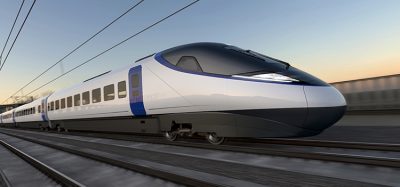Austria’s Southern Line – the future of travelling and transport
Posted: 25 July 2016 | Franz Bauer | No comments yet
The Southern Line in Austria is one of the largest and most spectacular infrastructure projects of the coming decade. Approximately 200km of railway lines will be modernised and 170km newly built. This will lead to the employment of 5,000 people during construction. In 2026 trains will travel from Vienna to Klagenfurt in just 2h40 and from Graz to Klagenfurt in 45 minutes. Covering a total of 470km, they will pass at high speeds through numerous new railway stations and through the Semmering and the Koralpe mountains. Franz Bauer, Member of the Executive Board at ÖBB-Infrastruktur AG, provides more information about construction as well as the other benefits the line will bring.
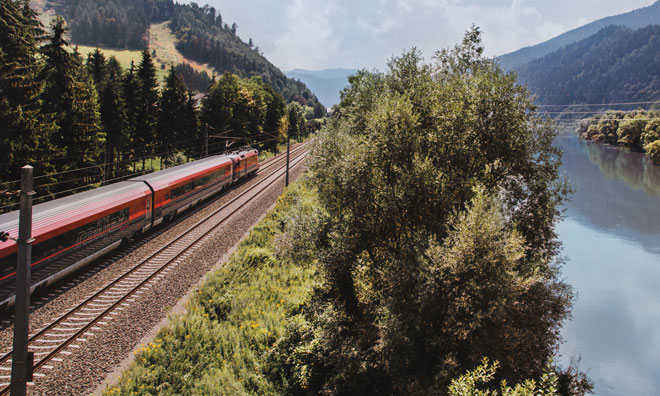

Increased mobility, fewer detours
Approximately 3.5 million people live in the Southern Line’s commuter belt. They want to be mobile and enjoy internationally imported goods from all around the world. ÖBB-Infrastruktur AG – Austria’s largest creator of railway infrastructure – is dedicated to fulfilling this wish and one of its most important tasks is to expand the North-South railway connection. In concrete terms, this translates into more than a quarter of a century of hard work and dedication for 170km of new and 200km of modernised railway lines.
More Europe, fewer borders
ÖBB-Infrastruktur AG is working on more than 100 large- and small-scale projects along the so-called Baltic-Adriatic Corridor from north to south. Stretching between the Baltic and Adriatic seas, this area covers a total of 1,700km and is both favoured and co-financed by the European Union. For Austria, the inclusion of the Southern Line in this far-reaching, trans-European connection means valuable access to emerging economies and the most important seaports.
More railway, less road-use
The Southern Line includes: the expansion of the Northern Line; the new Vienna Main Station; the new Freight Centre Vienna South; the Pottendorfer line (soon-to-be a high-performance line); the Semmering Base Tunnel; eight modernised railway stations between Bruck and Graz; the revamped Graz Main Station; and the 130km-long Koralm Line. Together, this mix will lay the foundation for future-orientated passenger and freight transportation.
More freedom, shorter travel times
Every year, 34 million passengers travel on Austria’s long-distance trains – twice as many as before the turn of the millenium. People leave their cars at home and travel by train if attractive connections are available. Proof of this has been seen after the expansion of the 300km-long Western Line between Vienna and Salzburg. We expect the same development for the approximately 470km-long Southern Line (including the Northern Railway), whose commuter belt is home to more people than the Western Line.
More possibilities, fewer restrictions
In addition to the current 37 million passengers, the Southern Line will also transport 109.3 million tonnes of goods each year. An extended, high-performance line allows these goods to reach their destination even faster. Thanks to its new, large tunnel, the Semmering is no longer a lengthy, expensive obstacle and the new Koralm Line bypasses the narrow Mur Valley and the steep Neumarkter Sattel.
More efficiency, less consumption
This straightened line enables freight trains to carry heavier loads for longer periods of time – and with the benefit of just one traction unit. This decreases road traffic, protects the environment, and drastically reduces transport costs. Each tonne of freight that is transported by train rather than truck decreases carbon dioxide emissions fifteenfold.
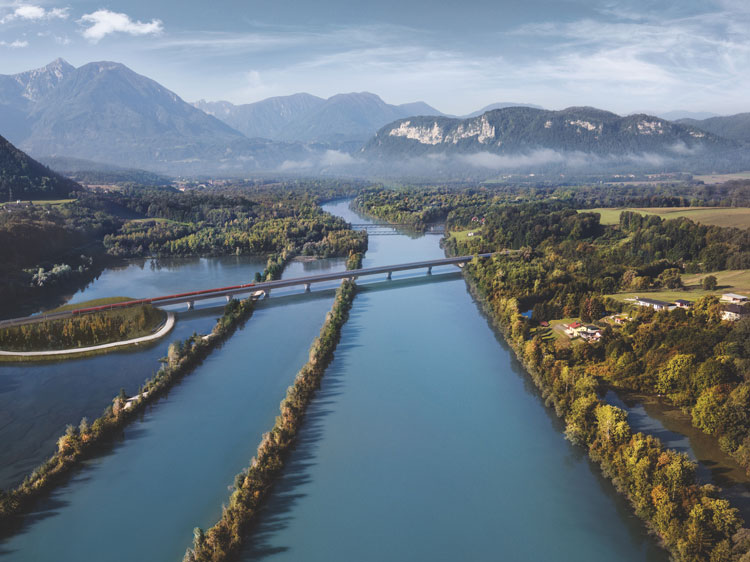

The Southern Line in Austria is one of the largest and most spectacular infrastrucure projects of the coming decade
Northern Line – more connections and fewer borders, bringing Europe closer together
18 new train stops on the way through the wine district
ÖBB-Infrastruktur AG is developing the Northern Line across 66km between Vienna’s Süßenbrunn Station and Lower Austria’s Bernhardsthal Station. This will make the railway line along the Czech border faster and safer. Busy railway crossings will be closed and replaced with underpasses and overpasses; the 18 train stops will be remodeled to become barrier-free and equipped with rail-free access to the platforms.
160km/h to Prague
The goal is to bring Austria and the Czech Republic even closer together. Starting in 2026, Northern Railway trains will race back and forth at 160km/h. Passengers will be able to travel from Vienna to the South Moravian village of Breclav in just an hour and the journey to Prague will take a mere 3h45; an entire 30 minutes faster than at present. Freight transport will equally benefit from this line expansion. Plans for the new Northern Line have only just begun. The first step will be an environmental impact assessment, i.e. the assessment of possible effects on mankind, animals and the environment.
Vienna Main Station – more than a railway station: city, campus, Viennese districts and European station
A hub in the European transportation network
On 109-hectares of land the full Vienna main station project is one of the largest building projects of the last decade in the city and country. It brings together a new station building with the development of a whole district. On what was once the southern station, ÖBB-Infrastruktur AG built a modern through-station between 2010 and 2015. Trains can arrive and immediately leave again from all directions. The Austrian capital has become even more of a central hub than before – not just for regional and national traffic but now also on the trans-European rail network. The large building is flooded with light thanks to its diamond-shaped roof which is now known as the ‘Vienna Main Station’ and includes around 90 shops and restaurants.
Faster connections between Western Austria and the Airport
Since mid-December 2015 all of the strings of the Vienna Main Station have come together. Following three years of reduced operation, all of the international and national Austrian express trains now zoom in and out, including trains from the west. A train from Innsbruck, Salzburg and Linz brings passengers directly to Vienna International Airport every 30 minutes. The changes are now easy, with short stopping times and good connections: travelling by rail is, essentially, getting much easier.
Freight Centre Vienna South – how to truly combine road and rail: the emergence of a modern freight terminal
55-hectares and hundreds of freight containers
In the south of Vienna, in the district of Favoriten, near the industrial area of Inzersdorf, ÖBB-Infrastruktur AG is constructing a trading centre, otherwise referred to in the transportation industry as an ‘intermodal terminal’. Roughly 30km of new operational tracks are currently being laid, and the necessary operational buildings and access roads are under construction. In fully operational mode, the 55-hectare facility will include container storage areas and heavy load gantry cranes. An ‘Intermodal’ terminal can be defined as a point at which different modes of transport and traffic routes meet. For example, one and the same container can be transported by train and then lorry, or vice versa; the goods do not have to be unloaded, moved and reloaded, saving time and money.
Faster transportation between Vienna and the rest of Europe
Freight Centre Vienna South will be a modern transportation hub from the Vienna region to the most important economic centres in all of Europe. Another key aspect is a good connection to the new economic region in the Balkans. Together with freight transport to the west, a high-performance network will also be constructed, which will optimally connect the Vienna region to trading partners. Transport to the important seaports for international shipping is also a significant function of the freight centre. Harbours, river routes, motorways and railway stations are thus woven together to form a system. The first facility – the terminal area of the freight centre – will commence operation at the end of 2016. The entire freight centre will be complete by the end of 2017.
Pottendorfer Line – four tracks between Vienna and Wiener Neustadt: a second ‘southern line’ for commuters
Convenient, fast return travel to Vienna
Until 2023 ÖBB-Infrastruktur AG will be modernising the Pottendorfer Line, a 52km-long extension route on the Southern Line. This second route begins in Vienna Meidling and travels to Lower Austria, via Wampersdorf, a district of the eponymous area Pottendorf and on to Wiener Neustadt. It will be a modern two-track high-performance route for trains to run at up to 200km/h. The updated line between Vienna Meidling and Wiener Neustadt will be used by thousands of commuters on their way to work every day in the capital. A large part of the railway line is already runnning as a two-track line and has been through the upgrade already: the section between Wampersdorf and Wiener Neustadt and – apart from one leg – the section between the station of Vienna Meidling and the new Vienna Blumental stop, which is near the existing Freight Centre Vienna South.
Semmering Base Tunnel – Vienna–Graz in 1hr50: in the future, Semmering will no longer be a bottleneck
Rapid transportation, even for heavy freight trains
The Semmering Base Tunnel’s route connects the Lower Austrian town of Gloggnitz to the Styrian town of Mürzzuschlag through the Semmering massif. It is exactly 27.3km-long and creates the conditions for future-orientated passenger and goods transport with its two tunnel tubes, which will be completed in 2026. The travel time for passengers from Vienna to Graz will be reduced by 50 minutes. Unlike the mountain route of the historical Semmering railway, even heavy freight trains can travel with just one traction unit on the incomparable base tunnel. One of the bottlenecks on the Baltic-Adriatic corridor is thus avoided.
The historic Semmering Train
The new tunnel takes some of the burden off of the timehonoured Semmering and Ghega railways – the first mountain railway to be declared a UNESCO world heritage site. The railway section, the viaducts, the tunnel and the station are currently being renovated and modernised to ensure that operation can be maintained. The railway is steeped in history and remains a beloved travel destination.
Bruck an der Mur–Graz Line – modernised railway stations and increased quality for passengers
Eight modernised railway stations and train stops
On a 53km-long rail section between Bruck an der Mur and Graz, ÖBB-Infrastruktur AG will be working until 2023 to bring eight stations and train stops up-to-date. They are exchanging rails and overhead lines, considering future right-hand running and rebuilding or creating the buildings. With the display boards, ticket machines and direction systems, the stations will be light and clearly arranged. They have to be prepared for what is predicted for the considerably ‘faster’ southern line: a lot more passengers.
Graz Main Station – one railway station for over 40,000 people: Graz will serve as a second international transport hub after Vienna
Railway station reconstruction from A to Z
Approximately 41,000 people enter Graz Main Station every day. They arrive or depart; wait for other travellers, or accompany them themselves. With the completion of the Koralm Line in 2023, the Graz Main Station will be even more significant – for international travel too – because it is on one of the most important north-south transversals of Europe. This required a complete modernisation from A to Z. All of the railway systems had to be renovated and expanded. The ‘Graz Main Station’ project began in 2009 and was completed by autumn 2015. However, it involved more than an expansion of a railway station; it involved several infrastructure projects from the ÖBB, the city of Graz, the Graz Holding and the state of Styria, as well as numerous new buildings.
Koralm Line – off to the south on 130km of new railway lines past 23 stations and through many new tunnels
Faster connections to Southern Austria
Since 1999 ÖBB-Infrastruktur AG has been building the Koralm Line in Styria and since 2001 in Carinthia, a new130km-long stretch of railway. This line makes southern Austria easier to reach. South Carinthia and West Styria are also now easier to access as both regions are getting closer to the state capital, Graz and Klagenfurt. The Koralm Line transports people and goods more quickly, with short journey times and at short intervals. With its completion in 2023, a journey from Graz to Klagenfuhrt will take only 45 minutes – instead of the two hour bus journey that was previously required – and passengers travelling from Graz to Venedig will be delighted with a time saving of up to four hours. In future, people will be able to glide through the countryside along the whole Koralm line at up to 230km/h.
The sixth-longest railway tunnel in the world
For a quarter of the section, the trains will travel through tunnels; the longest being the Koralm tunnel at 32.9km. It is the sixth longest railway tunnel in the world and connects Styria with Carinthia and the Deutschlandsberg area with the middle of the Lavant Valley. Along the line, 11 stations have been, or are currently being, completely modernised with 12 being newly built: those in Styria; the stations Kalsdorf, Werndorf and Wettmannstätten; as well as the Hengsberg stop; in the local transport hubs Don Bosco and Puntigam; and in Klagenfurt, the station Klagenfurt Ebenthal. These stations are significant as they are a guarantee for the regional use of the Koralm line. Thousands of people will get on and off here and this will be to their advantage
Biography
Franz Bauer studied civil engineering at the Vienna University of Technology between 1980 and 1985 before joining the Vienna Metro construction team at Ingenieurbüro Schickl. Between 1987 and 1989 Franz joined ÖBB-Generaldirektion on the ‘new railway tunnel construction projects’ team. Between 1989 and 2006 he was Project Manager for the Semmering Base Tunnel and Winerwald Tunnel at Eisenbahn-Hochleistungsstrecken AG specialising in geotechnics and tunnel construction work. In 2007 he joined ÖBB-Infrastruktur AG as Division Manager for New Construction and Expansion, and has been Member of the Executive Board since 2013.



